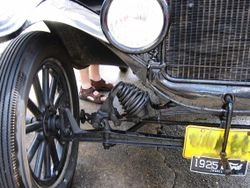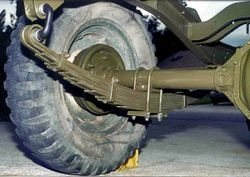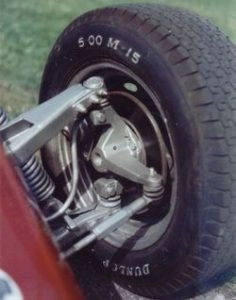The importance of the car's suspension system lies in its assistance in providing stability and steadiness to the steering system. It also helps in safe control, ensuring the passengers' comfort during driving. It accomplishes all these tasks by increasing the friction between the tires and the road surface. In addition to the aforementioned, the car's suspension system has other benefits. It aids in maintaining the correct height of the car, aligning the tires, and plays a role in steering the car and protecting it from damage while preserving the tires in a vertical position.
It is practically impossible for roads to be perfectly flat, no matter how accurate their paving. There will always be minor defects that prevent tire stability. In addition, the presence of cat's eyes on the road may cause the tires to move vertically up and down, which could result in the tires losing contact with the road. Therefore, there was a need for a system that ensures stability and balance, and helps absorb the energy of tires accelerating vertically. Naturally, the system referred to here is the car's suspension.

What are the components of the suspension system?
Despite the existence of more than one different type.Suspension SystemHowever, all types consist of main components that may be unfamiliar to many people, and these components are:
The Joint
One of the components of the car suspension system that assists the front tires in moving in both the right and left directions, this part is located above the lower axle.
Balance Shafts
You may find more than one common name for these parts, they are also known as anti-sway bars, or anti-roll bars. Regardless of the name, these components contribute to providing more stability to the car, as well as their importance in reducing the body roll of the car when turning quickly. Also read:4 Symptoms Indicate the Failure of the Air Sensor
The Links
The car suspension system consists of solid links used to connect the chassis with the tire joints, called links. This linking process is carried out through mechanical fixtures that come in various forms. These forms are:
Firstly: The scissors
It refers to a mechanical connection in the shape of the letter A. One end features the car's joint, which is mounted on the hinge, while the other ends are connected to the car's structure using the scissors skin. The scissors skin acts as a mediator between the car's structure.The car's scissors jack This aids in their cohesion with each other, and in general, a car's suspension can move in all directions. Some come with grease, while others come without. Some cars have more than one control arm, potentially containing both an upper and lower control arm together, while others only have one lower control arm. The determinant of the number is the type of car.
Secondly: The Solid Axle
This type of connector is used in trucks, it helps in linking the chassis with the joint on the frame, and this rigid axial cover aids in supporting the total weight of the car or truck.

Thirdly: Multiple Links
It serves as an alternative to the previous types, and many cars use it as a tool to connect the car's frame to the joint.
Shock absorbers
This is one of the most importantMechanical MeansThese help absorb shocks on the road, and are placed between the links and the chassis to minimize shocks to the greatest extent possible before they transfer to the chassis. In addition, they have several other important roles, such as supporting the additional weights on the car and maintaining a specific height of the car.
Car Assistance
It is one of the components of the car's suspension system that helps in slowing down the movement of the springs, reducing the amount of vibrations. It transforms kinetic energy into thermal energy.
Types of Suspension Systems
The evolution of cars has been accompanied by the development of the car suspension system, leading to four main types.
Independent suspension system
Its design allows the tires to move vertically up and down when driving on uneven roads. Despite numerous benefits and positives of this type, it is not devoid of some negatives. The highlights of this car suspension system are that it provides better driving quality, additionally, it doesn't require much space, and it gives the driver easy steering, and lightness and agility in weight. However, the most notable downside of it is the difficulty in eliminating road noise.
Non-independent suspension system
This type distinguishes itself from its predecessor in its superior shock absorption, consisting of a constant connection between the tires, so the force affecting one tire affects the opposite one. This type of car suspension system is used by heavy vehicles.
Semi-independent suspension system
This type is a combination of the two previous types, and the tires move thanks to this type of car suspension system as is the case in the independent system. Added to this is that the position of one tire affects the other tire, and this type is most often used in the rear tires.

A suspension system with modern technology.
Companies continue to develop car parts consistently, and they have managed to develop advanced suspension systems. Some of these rely on magnetic fluid suspension technologies, where a magnetic shock absorber filled with a fluid is used, controlled via a magnetic field. Others rely on linear electromagnetic suspension technologies, where a single linear electromagnetic motor is used in each wheel instead of using traditional shock absorbers and springs.

Comments